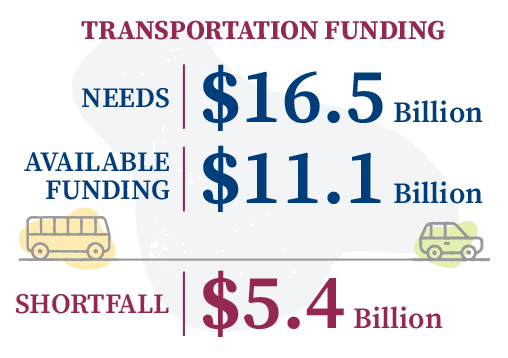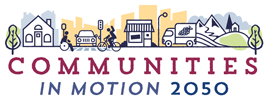
Financial Plan
Do you use a budget? Is it balanced? That is, does your income meet (or exceed!) your needs?
Through Communities in Motion 2050, COMPASS anticipates transportation needs in Ada and Canyon Counties to the year 2050 and aligns those needs with forecasted funding. By doing this, the plan is not simply a “wish list” of transportation projects, but is a balanced budget, laying the foundation for what projects can, and cannot, realistically be implemented by 2050.
How much money is there?
Based on forecasted federal, state, and local transportation funding, COMPASS estimates $11.1 billion (yes, with a “b”) in transportation funding will be available for projects in Ada and Canyon Counties to 2050. That is a lot of money; however, keep in mind that amount is spread over 28 years and the needs are even greater, estimated at $16.5 billion.

How will it be spent?
Just as the plan is not simply a “wish list,” decisions on which projects will be funded are not taken lightly. COMPASS used a detailed process to identify the highest priority projects; that process, in turn, is guided by a funding policy:
- Use anticipated available funding in Ada and Canyon Counties to strategically address regional priorities as identified in the regional long-range transportation plan.
- Focus federal formula funds in Ada County on maintaining the existing transportation network and fill gaps in the alternative transportation system. Use new available funding to strategically address regional priorities.
- Use federal formula funds in Canyon County to address regional priorities as identified in the regional long-range transportation plan.
Projects funded in the plan include everything from new roads and pathways to replacing transit buses to improving safety to conducting maintenance on all types of transportation facilities.
What’s the shortfall?
Even with $11.1 billion in anticipated revenue, the region remains $5.4 billion short of meeting the $16.5 billion in forecasted transportation needs by 2050. To look at it another way, that calculates to $193 million per year, or about 68¢ per person per day – less than the cost of a pack of gum.
This shortfall not only hampers the ability to grow the transportation system—add more buses and bike paths or widen roads—but it also means that some needed maintenance is delayed or left undone. This deferred maintenance hurts us all:
- Additional wear and tear (and repairs) on vehicles caused by unmaintained roads
- Increased safety hazards
- Higher costs when portions of the transportation system can no longer be repaired and must be rebuilt or replaced

What is COMPASS doing about it?
COMPASS is taking a four-pronged approach to addressing the funding shortfall:
- Working with the Idaho Legislature, Congress, and other decision-makers to develop long-term, sustainable increases in transportation funding
- Actively pursuing competitive grants to fund high-priority projects
- Using performance-based planning to ensure the best use of limited funds
- Focusing some types of federal funding on maintenance to keep the existing transportation system in good shape

